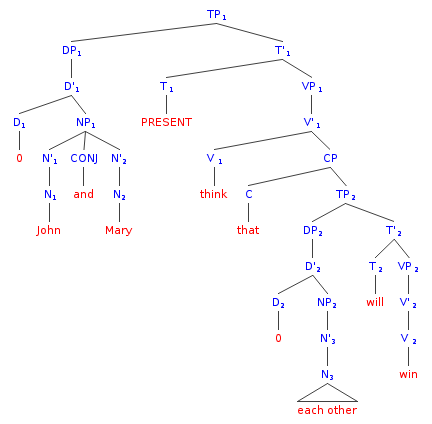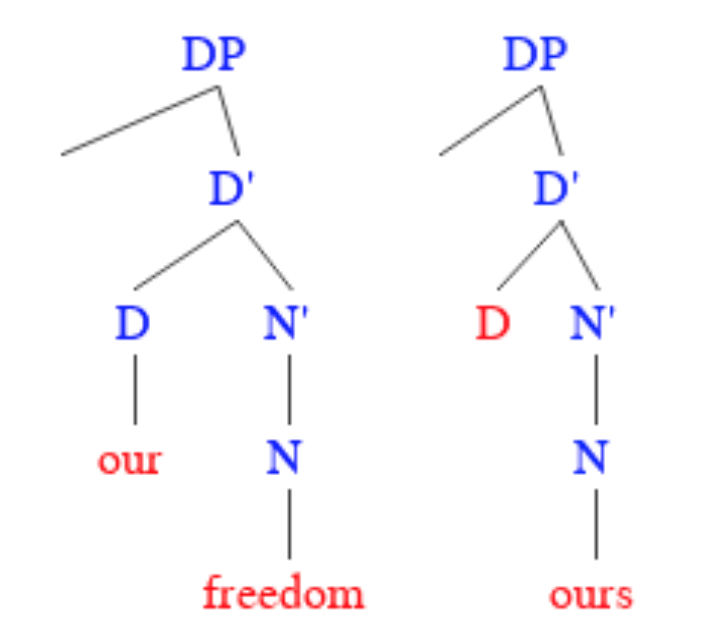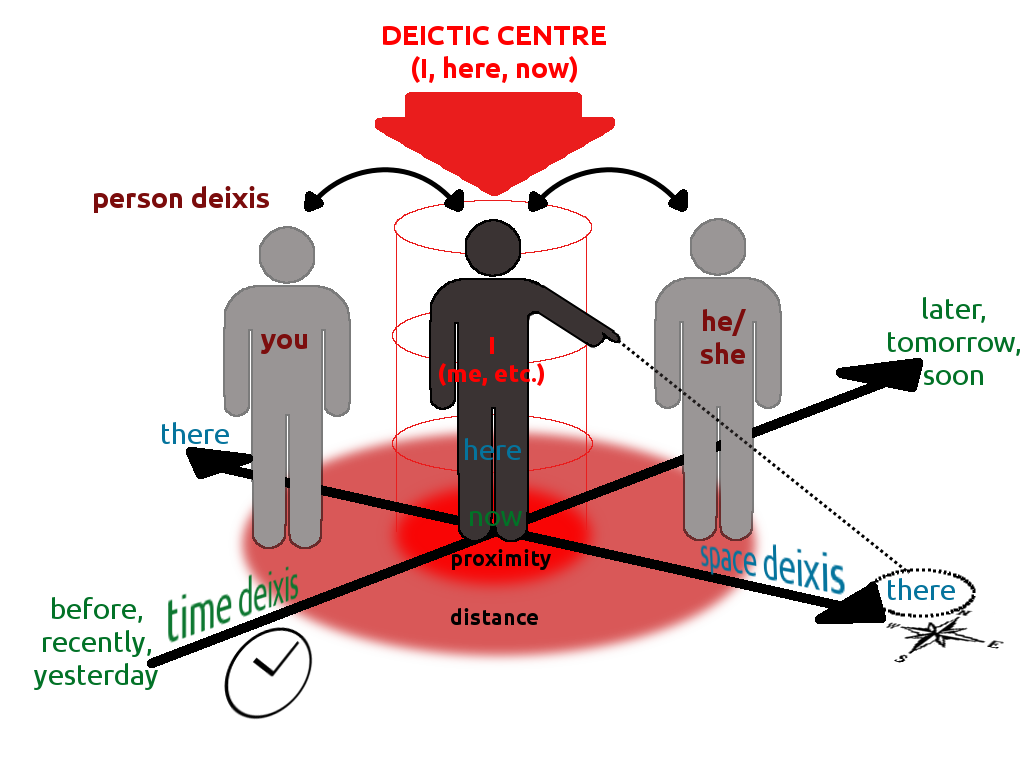|
Anaphor
In linguistics, anaphora () is the use of an expression whose interpretation depends upon another expression in context (its antecedent or postcedent). In a narrower sense, anaphora is the use of an expression that depends specifically upon an antecedent expression and thus is contrasted with cataphora, which is the use of an expression that depends upon a postcedent expression. The anaphoric (referring) term is called an anaphor. For example, in the sentence ''Sally arrived, but nobody saw her'', the pronoun ''her'' is an anaphor, referring back to the antecedent ''Sally''. In the sentence ''Before her arrival, nobody saw Sally'', the pronoun ''her'' refers forward to the postcedent ''Sally'', so ''her'' is now a ''cataphor'' (and an anaphor in the broader, but not the narrower, sense). Usually, an anaphoric expression is a pro-form or some other kind of deictic (contextually dependent) expression. Both anaphora and cataphora are species of endophora, referring to something menti ... [...More Info...] [...Related Items...] OR: [Wikipedia] [Google] [Baidu] |
Binding (linguistics)
In linguistics, binding is the phenomenon in which anaphoric elements such as pronouns are grammatically associated with their antecedents. For instance in the English sentence "Mary saw herself", the anaphor "herself" is bound by its antecedent "Mary". Binding can be licensed or blocked in certain contexts or syntactic configurations, e.g. the pronoun "her" cannot be bound by "Mary" in the English sentence "Mary saw her". While all languages have binding, restrictions on it vary even among closely related languages. Binding has been a major area of research in syntax and semantics since the 1970s, and was a major for the government and binding theory paradigm. Some basic examples and questions The following sentences illustrate some basic facts of binding. The words that bear the index i should be construed as referring to the same person or thing. ::a. Fredi is impressed with himselfi. – Indicated reading obligatory ::b. *Fredi is impressed with himi. – Indicated reading im ... [...More Info...] [...Related Items...] OR: [Wikipedia] [Google] [Baidu] |
Cataphora
In linguistics, cataphora (; from Greek, '' καταφορά'', ''kataphora'', "a downward motion" from '' κατά'', ''kata'', "downwards" and '' φέρω'', ''pherō'', "I carry") is the use of an expression or word that co-refers with a later, more specific, expression in the discourse. The preceding expression, whose meaning is determined or specified by the later expression, may be called a cataphor. Cataphora is a type of anaphora, although the terms ''anaphora'' and ''anaphor'' are sometimes used in a stricter sense, denoting only cases where the order of the expressions is the reverse of that found in cataphora. An example of cataphora in English is the following sentence: * When he arrived home, John went to sleep. In this sentence, the pronoun ''he'' (the cataphor) appears earlier than the noun ''John'' (the postcedent) that it refers to. This is the reverse of the more normal pattern, "strict" anaphora, where a referring expression such as ''John'' or ''the soldier' ... [...More Info...] [...Related Items...] OR: [Wikipedia] [Google] [Baidu] |
Reciprocal Pronoun
A reciprocal pronoun is a pronoun that indicates a reciprocal relationship. A reciprocal pronoun can be used for one of the participants of a reciprocal construction, i.e. a clause in which two participants are in a mutual relationship. The reciprocal pronouns of English are ''one another'' and ''each other'', and they form the category of anaphors along with reflexive pronouns (''myself'', ''yourselves'', ''themselves,'' etc.). Defining properties Semantics of reciprocal relation Reflexive pronouns are used similarly to reciprocal pronouns in the sense that they typically refer back to the subject of the sentence. (1) ''John and Mary like themselves.'' (2) ''John and Mary like each other.'' The main difference between reflexives, as in example (1), and reciprocal pronouns, as in example (2), is that reflexives are used when the subject acts upon itself, while reciprocals are used when members of a group perform the same action relative to one another. Reciprocal pronouns ... [...More Info...] [...Related Items...] OR: [Wikipedia] [Google] [Baidu] |
Pronoun
In linguistics and grammar, a pronoun (abbreviated ) is a word or a group of words that one may substitute for a noun or noun phrase. Pronouns have traditionally been regarded as one of the parts of speech, but some modern theorists would not consider them to form a single class, in view of the variety of functions they perform cross-linguistically. An example of a pronoun is "you", which can be either singular or plural. Subtypes include personal and possessive pronouns, reflexive and reciprocal pronouns, demonstrative pronouns, relative and interrogative pronouns, and indefinite pronouns. The use of pronouns often involves anaphora, where the meaning of the pronoun is dependent on an antecedent. For example, in the sentence ''That poor man looks as if he needs a new coat'', the meaning of the pronoun ''he'' is dependent on its antecedent, ''that poor man''. The name of the adjective that belongs with a "pronoun" is called a "pronominal". A pronominal is also a word or ph ... [...More Info...] [...Related Items...] OR: [Wikipedia] [Google] [Baidu] |
Deixis
In linguistics, deixis (, ) is the use of general words and phrases to refer to a specific time, place, or person in context, e.g., the words ''tomorrow'', ''there'', and ''they''. Words are deictic if their semantic meaning is fixed but their denoted meaning varies depending on time and/or place. Words or phrases that require contextual information to be fully understood—for example, English pronouns—are deictic. Deixis is closely related to anaphora. Although this article deals primarily with deixis in spoken language, the concept is sometimes applied to written language, gestures, and communication media as well. In linguistic anthropology, deixis is treated as a particular subclass of the more general semiotic phenomenon of indexicality, a sign "pointing to" some aspect of its context of occurrence. Although this article draws examples primarily from English, deixis is believed to be a feature (to some degree) of all natural languages.Lyons, John (1977) "Deixis, space an ... [...More Info...] [...Related Items...] OR: [Wikipedia] [Google] [Baidu] |
Discourse Representation Theory
In formal linguistics, discourse representation theory (DRT) is a framework for exploring meaning under a formal semantics approach. One of the main differences between DRT-style approaches and traditional Montagovian approaches is that DRT includes a level of abstract mental representations (discourse representation structures, DRS) within its formalism, which gives it an intrinsic ability to handle meaning across sentence boundaries. DRT was created by Hans Kamp in 1981. A very similar theory was developed independently by Irene Heim in 1982, under the name of ''File Change Semantics'' (FCS). Discourse representation theories have been used to implement semantic parsers and natural language understanding systems.Rapaport, William J.Syntactic semantics: Foundations of computational natural-language understanding" Thinking Computers and Virtual Persons. 1994. 225-273. Discourse representation structures DRT uses ''discourse representation structure''s (DRS) to represent a hearer' ... [...More Info...] [...Related Items...] OR: [Wikipedia] [Google] [Baidu] |
Endophora
Endophora refers to the phenomenon of expressions that derive their reference from something within the surrounding text (endophors). For example, in the sentences "I saw Sally yesterday. She was lying on the beach", "she" is an ''endophoric'' expression because it refers to something mentioned elsewhere in the text, i.e. "Sally". By contrast, "She was lying on the beach," if it appeared by itself, contains an ''exophoric'' expression; "she" refers to something that is not present in the surrounding text, so there is not enough information given within the text to independently determine to whom "she" refers. It can refer to someone the speaker assumes his audience has prior knowledge of, or it can refer to a person he is showing to his listeners. Without further information, in other words, there is no way of knowing the exact meaning of an exophoric term. Endophora can be broken into three subcategories: cataphora In linguistics, cataphora (; from Greek, '' καταφορά'' ... [...More Info...] [...Related Items...] OR: [Wikipedia] [Google] [Baidu] |
Antecedent (grammar)
In grammar, an antecedent is an expression (word, phrase, clause, sentence, etc.) that gives its meaning to a proform (pronoun, pro-verb, pro-adverb, etc.). A proform takes its meaning from its antecedent; e.g., "John arrived late because traffic held him up." The pronoun ''him'' refers to and takes its meaning from ''John'', so ''John'' is the antecedent of ''him''. Proforms usually follow their antecedents, but sometimes they precede them, in which case one is, technically, dealing with postcedents instead of antecedents. The prefix ''ante-'' means "before" or "in front of", and ''post-'' means "after" or "behind". The term ''antecedent'' stems from traditional grammar. The linguistic term that is closely related to ''antecedent'' and ''proform'' is '' anaphora''. Theories of syntax explore the distinction between antecedents and postcedents in terms of binding. Examples Almost any syntactic category can serve as the antecedent to a proform. The following examples illustrate a r ... [...More Info...] [...Related Items...] OR: [Wikipedia] [Google] [Baidu] |
Reflexive Pronoun
A reflexive pronoun is a pronoun that refers to another noun or pronoun (its antecedent) within the same sentence. In the English language specifically, a reflexive pronoun will end in ''-self'' or ''-selves'', and refer to a previously named noun or pronoun (''myself'', ''yourself'', ''ourselves'', ''themselves'', etc.). English intensive pronouns, used for emphasis, take the same form. In generative grammar, a reflexive pronoun is an anaphor that must be bound by its antecedent (see binding). In a general sense, it is a noun phrase that obligatorily gets its meaning from another noun phrase in the sentence. Different languages have different binding domains for reflexive pronouns, according to their structure. Origins and usage In Indo-European languages, the reflexive pronoun has its origins in Proto-Indo-European. In some languages, some distinction exists between normal object and reflexive pronouns, mainly in the third person: whether one says "I like me" or "I ... [...More Info...] [...Related Items...] OR: [Wikipedia] [Google] [Baidu] |
Pragmatics
In linguistics and related fields, pragmatics is the study of how context contributes to meaning. The field of study evaluates how human language is utilized in social interactions, as well as the relationship between the interpreter and the interpreted. Linguists who specialize in pragmatics are called pragmaticians. Pragmatics encompasses phenomena including implicature, speech acts, relevance and conversation,Mey, Jacob L. (1993) ''Pragmatics: An Introduction''. Oxford: Blackwell (2nd ed. 2001). as well as nonverbal communication. Theories of pragmatics go hand-in-hand with theories of semantics, which studies aspects of meaning, and syntax which examines sentence structures, principles, and relationships. The ability to understand another speaker's intended meaning is called ''pragmatic competence''. Pragmatics emerged as its own subfield in the 1950s after the pioneering work of J.L. Austin and Paul Grice. Origin of the field Pragmatics was a reaction to structuralist l ... [...More Info...] [...Related Items...] OR: [Wikipedia] [Google] [Baidu] |
Natural Language Processing
Natural language processing (NLP) is an interdisciplinary subfield of linguistics, computer science, and artificial intelligence concerned with the interactions between computers and human language, in particular how to program computers to process and analyze large amounts of natural language data. The goal is a computer capable of "understanding" the contents of documents, including the contextual nuances of the language within them. The technology can then accurately extract information and insights contained in the documents as well as categorize and organize the documents themselves. Challenges in natural language processing frequently involve speech recognition, natural-language understanding, and natural-language generation. History Natural language processing has its roots in the 1950s. Already in 1950, Alan Turing published an article titled "Computing Machinery and Intelligence" which proposed what is now called the Turing test as a criterion of intelligence, t ... [...More Info...] [...Related Items...] OR: [Wikipedia] [Google] [Baidu] |
Generalized Quantifier Theory
A generalization is a form of abstraction Abstraction in its main sense is a conceptual process wherein general rules and concepts are derived from the usage and classification of specific examples, literal ("real" or "concrete") signifiers, first principles, or other methods. "An abstr ... whereby common properties of specific instances are formulated as general concepts or claims. Generalizations posit the existence of a domain or set theory, set of elements, as well as one or more common characteristics shared by those elements (thus creating a conceptual model). As such, they are the essential basis of all valid deductive inferences (particularly in logic, mathematics and science), where the process of falsifiability, verification is necessary to determine whether a generalization holds true for any given situation. Generalization can also be used to refer to the process of identifying the parts of a whole, as belonging to the whole. The parts, which might be unrelated w ... [...More Info...] [...Related Items...] OR: [Wikipedia] [Google] [Baidu] |




